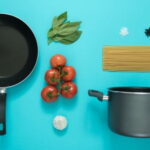Ceramic vs Stainless Steel Cookware: Which one to Choose?

Cookware is an essential part of any kitchen. There are a variety of materials that can be used for cookware, but the two most popular types are ceramic and stainless steel.
If you’re wondering what kind of cookware to buy, you may be considering ceramic vs stainless steel cookware.
What’s the difference between these two materials?
Which is better for cooking: ceramic or stainless steel cookware?
These are the question that many people have, and the answer is not always clear. Both types of cookware have their pros and cons, so it really depends on what you are looking for in a pot or pan.
But before that, it’s important to know the difference between ceramic and stainless steel cookware before making a decision on which is better for you.
Ceramic vs Stainless Steel Cookware: Difference
Ceramic vs Stainless Steel Cookware: What is the difference between both materials? Let’s take a closer look at each one.
Ceramic Cookware
Material
Before going to talk about Ceramic Cookware first of all we will know about the types of ceramic cookware.
There are broadly two types of ceramic cookware:
100% Ceramic
100% Ceramic cookware is made from a clay called kaolin. This clay is first molded into shape and then fired in a kiln at temperatures exceeding 1,000 degrees Celsius. This high temperature strengthens the cookware and makes it more durable.
Ceramic Coated
Ceramic-coated cookware is made by first coating a metal base (usually aluminum or steel) with a layer of ceramic. This coating is usually applied via a process called “sol-gel”, which involves mixing a ceramic powder with a liquid to form a gel. The gel is then applied to the metal surface and heated until it hardens into a ceramic coating.
Throughout this article, we will be talking about Ceramic Coated Cookware because most of the cookware available in the market is coated rather than being 100% ceramic.
Pros of Ceramic Coated Cookware
Non-toxic: Ceramic cookware is made from natural materials, so it is free of harmful chemicals like PFOA and PTFE. This is the biggest reason why people choose ceramic cookware over other types.
Non-stick: The smooth surface of ceramic cookware is ideal for cooking foods that tend to stick, like eggs and pancakes.
Scratch-resistant: The ceramic coating is much more scratch-resistant than other non-stick coatings, like Teflon.
Easy to clean: Ceramic cookware is generally easier to clean than other types of cookware since the non-stick surface releases food easily. You can usually just wipe it clean with a damp cloth.
Stylish: Ceramic cookware comes in a variety of colors and styles, so you are sure to find a set that matches your kitchen décor.
Non-Reactive: Unlike Aluminum cookware which reacts with acidic foods, ceramic is non-reactive. This means you can cook acidic foods like tomato sauce without worrying about the food taking on a metallic flavor.
Even Heat Distribution: As we said earlier the base of ceramic coated cookware is mostly made up of aluminum which is a good conductor of heat. So the heat is distributed evenly throughout the cookware.
Healthy Cooking: Since ceramic cookware is non-stick, you don’t need to use as much oil when cooking. This tends to be healthier since it cuts down on the amount of fat and calories in your food.
Cons of Ceramic Cookware
Not Induction Safe: When it comes to pure ceramic cookware, it is not compatible with induction cooktops. However, some ceramic-coated cookware especially the one which has a steel base can be used on induction cooktops.
Shorter Lifespan: Even though ceramic cookware is quite durable, it has a shorter lifespan than other types of cookware. The ceramic coating can start to chip and flake off after a few years of use.
Not Metal Utensil Safe: Since the ceramic coating is relatively soft, it can be scratched by metal utensils. This means you have to be careful when using metal spatulas, knives, etc. with ceramic cookware.
Who Should Choose Ceramic?
Ceramic cookware is a good choice for people who are looking for an alternative to Teflon or other non-stick coatings. It is also a good choice for people who are concerned about chemicals in their cookware.
It is also a good choice for people who want cookware that is easy to clean and doesn’t require seasoning.
Ceramic cookware is also very durable and can last for many years with proper care. However, it is important to note that ceramic cookware can be easily damaged. The glaze can chip or scratch, and the ceramic itself can break if it is dropped.
Stainless Steel Cookware
Material
Stainless steel is an alloy of various metals including iron, chromium, and nickel. The addition of these other metals makes the steel more resistant to rust and corrosion. It also gives the steel a shiny, polished look.
Stainless steel is a popular choice for cookware because it is durable and easy to care for. It is also a good conductor of heat, so it cooks food evenly.
So, when you see the word “stainless” on a pan or pot, it simply means that the steel used to make the cookware contains chromium and nickel.
Grades of Stainless Steel
One thing that is important to know about stainless steel cookware is the grades of stainless steel. There are three different grades of stainless steel: 18/8, 18/10, and 18/0.
The first number refers to the percentage of chromium in the stainless steel, while the second number stands for the percentage of nickel.
So, 18/8 means that there is 18% chromium and 8% nickel, while 18/10 has 18% chromium and 10% nickel.
The higher the percentage of Nickle in the stainless steel, the better quality and expensive the cookware will be.
18/10 is the highest quality you can find, while 18/0 is the least expensive and the least durable.
Pros of Stainless Steel Cookware
Non-reactive: Stainless steel is a non-reactive metal, which means that it won’t react with foods. This is important because some metals can react with certain foods and change the taste or color of the food.
So, if you are cooking something like tomato sauce, you don’t have to worry about the sauce absorbing any flavors from the pan.
Dishwasher-safe: Stainless steel cookware is dishwasher-safe, which makes cleanup a breeze.
You don’t have to worry about hand-washing your stainless steel pots and pans; just pop them in the dishwasher and let it do its job.
Versatile: With Stainless Steel cookware you can almost cook anything. From frying and sautéing to baking and boiling, you can do it all with stainless steel.
Induction safe: Stainless steel cookware can be used on all types of stovetops, including induction stoves.
An induction cooktop uses magnetic energy to heat the pan, so only materials that are attracted to magnets will work on this type of stove.
So, if you have an induction cooktop or are thinking about getting one, stainless steel is a good choice.
It can also be used in the oven, so it’s a good choice if you want one type of cookware that can do it all.
Doesn’t rust: Stainless steel is resistant to rust, so you don’t have to worry about your cookware rusting or corroding over time.
Even if you use your cookware frequently, it should last for years without showing any signs of wear and tear.
Cons of Stainless Steel Cookware
Poor Head Conduction: The first and most obvious downside to stainless steel cookware is that it is a poor conductor of heat.
This means that it takes longer to heat up and can result in uneven cooking.
However, tri-ply and multi-ply stainless steel cookware are designed to address this issue by adding an aluminum or copper core.
This core helps to conduct heat better, so your food will cook more evenly.
Not Non-Stick: Another downside to stainless steel cookware is that it is not non-stick.
So, if you are looking for cookware that will help you create perfect pancakes or eggs, stainless steel is not the way to go.
You will need to use oil or butter to prevent your food from sticking, which is not ideal if you are trying to eat healthily.
Expensive: Stainless steel cookware is not cheap. In fact, it can be quite expensive, especially if you are looking for high-quality cookware.
So, if you are on a budget, stainless steel might not be the best choice.
Who Should Choose Stainless Steel?
If you are looking for long-lasting, durable cookware that is versatile long-lasting, and easy to care for, stainless steel is a good choice.
It is also a good choice if you have an induction cooktop or are thinking about getting one.
However, if you are looking for non-stick cookware or are on a budget, stainless steel is not the best option.
Ceramic Vs Stainless Steel Cookware: Which one is Better?
Durability
First thing first, in terms of durability, stainless steel definitely takes the cake. It is more scratch-resistant than ceramic and can withstand high heat better.
Ceramic, on the other hand, is more prone to chipping and breaking. It also can’t handle high heat as well as stainless steel.
So, if you are looking for cookware that will last you a long time, stainless steel is the way to go.
Ease of Cleaning
When it comes to ease of cleaning, it really depends on your personal preferences.
Some people find that ceramic is easier to clean because there are no nooks and crannies for food to get stuck in.
Others find that stainless steel is easier to clean because it can go in the dishwasher.
So, it really comes down to what you are looking for in terms of ease of cleaning.
Cost
In terms of cost, stainless steel is definitely more expensive than ceramic.
However, it is important to keep in mind that stainless steel will last you much longer than ceramic, so it is worth the investment.
Ceramic is a good budget-friendly option, but it is not as durable or easy to care for as stainless steel.
So, if you are looking for the best value, stainless steel is the way to go.
Design
Ceramic cookware comes in a wide variety of designs and colors. You can find it in solid colors, and patterned designs.
Stainless steel is more utilitarian in design and doesn’t offer as many options in terms of color and pattern.
So, if you are looking for cookware that is both functional and stylish, ceramic is the way to go.
Healthy Cooking
Ceramic is a good choice for healthy cooking because it doesn’t contain any chemicals and is free from PFOA and PTFE.
Stainless steel is also a good choice for healthy cooking because it doesn’t react with acidic foods.
So, if you are looking for cookware that will help you to cook healthy meals, either ceramic or stainless steel is a good option.
However, ceramic has an edge over stainless steel because it doesn’t require the use of oils or butter to prevent sticking.
Stainless steel does require the use of oils or butter to prevent sticking, so it is not as healthy as ceramic.
Conclusion
When it comes to ceramic vs stainless steel cookware, it really depends on your needs and preferences.
If you’re looking for something that is durable and versatile, and can withstand high temperatures then stainless steel is a good option.
Bu,t you’re looking for an affordable option that is easy to clean and can offer better heat retention and even cooking, ceramic cookware may be the way to go.
Ultimately, the best cookware for you is the one that will meet your specific needs.
Related Posts:




